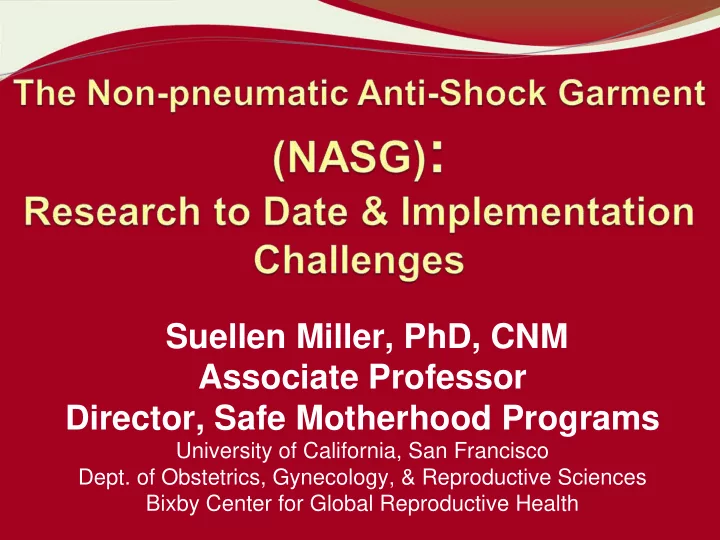

Suellen Miller, PhD, CNM Associate Professor Director, Safe Motherhood Programs University of California, San Francisco Dept. of Obstetrics, Gynecology, & Reproductive Sciences Bixby Center for Global Reproductive Health
Global NASG Team International UCSF � Mohamed Fathalla � Carinne Meyer � Oladosu Ojengbede � Hilarie Martin � Mohammed Mourad ‐ Youssif � Jessica Morris � Imran O Morhason ‐ Bello � Elizabeth Butrick � Hadiza Gallandanci � Janet Turan � David Nsima � Carol Camlin � Aminu I Momammed � Tarek AL Hussaini � Sheri Lippman � Gricelia Mkumba � Christine Kaseba � Rhoda Amafumba � Violet Mambo � Thulani Magwali
The Non-Pneumatic Anti Shock Garment (NASG) Neoprene and Applies Velcro lower-body Circumferential first aid device Counterpressure Reverses shock by shunting Decreases blood to vital further blood organs loss
Mechanism of Action In decompensatory shock, the heart, lungs and brain are deprived of oxygen as blood accumulates in the lower part of the body In obstetric hemorrhage, blood also leaves the body through the vagina or pools in the retroperitoneal area The NASG reverses shock by shunting blood from the lower extremities and abdomen to the heart, brain, lungs It reduces blood loss because it compresses the blood vessels. When the radius of a blood vessel is decreased, blood flow through the vessel is decreased
Number of women treated with NASG in studies: � Egypt Pilot = 260 � Egypt II = 558 � Nigeria = 573 � Zambia = 1711 � Zimbabwe = 507 ------------------------- Total = 3609
Obstetric Hemorrhage � Ectopic pregnancy � Molar pregnancy � Complications of abortion � Abruption of placenta � Ruptured uterus � Uterine atony (35%) � Vaginal, cervical or genital lacerations � Retained placenta or tissue � Placenta previa � Placenta accreta
Pre-Post Intervention Study N=1442 Egypt: 2 facilities Phase N=990 432 Pre ‐ intervention 558 NASG Nigeria: 4 facilities Phase N=452 175 Pre ‐ intervention 277 NASG
Study Entry Criteria � Women with hypovolemic shock secondary to obstetric hemorrhage (any etiology) � Estimated blood loss >750 mL (> 1000 in Egypt) � One or more clinical signs of hypovolemic shock � systolic blood pressure [SBP] < 100 mmHg pulse > 100 beats per minute [BPM] �
Study Outcomes � Median blood loss (measured with a plastic closed end calibrated collection drape) � Emergency hysterectomy � Severe end organ failures morbidity � Renal failure � Cardiac failure � ARDS � CNS � Mortality
Pre NASG P value 697 835 Estimated revealed blood <.0001 loss 1210.0 1327.5 (480.7) Mean mL (SD) (507.7) Median mL (IQR) 1000 (1000 ‐ 1200 1500) (1000 ‐ 1500) MAP < 60 181 (29.9) 321 (38.5) 0.001
Results: N=1442 Measured Blood Loss Pre NASG P value (N=607) (N=835) Measured vaginal blood loss in drape: 443.5 240.0 <0.001 Mean mL (SD) (346.1) (199.4) Median mL 400 200 (IQR) (250 ‐ 500) (150 ‐ 250) <0.001
Pre NASG Relative P value (N=607 (N=835 Risk ) ) (95%CI) E hyst 20 14 0.44 0.013 (8.9) (4.0) (0.23 ‐ 0.86) Morbidity 21 6 0.20 (3.7) (0.7) (0.08 ‐ 0.50) 0.001 Mortality 38 29 0.56 0.013 (6.3) (3.5) (0.35 ‐ 0.89)
CRCT - Zambia & Zimbabwe � Does transport in an NASG from a PHC to a referral hospital result in decreased maternal mortality and morbidity? Site Clusters Harare 12 Control clinic Referral Hospital Lusaka 12 Intervention clinic Copperbelt 14 Funding: NICHD & Bill & Melinda Gates Foundation
Challenges � Which systems have to be in place for the successful implementation of the NASG? � What are the barriers to the implementation of the NASG?
Necessary Systems � Access to basic PPH interventions/treatment and appropriate referrals � Regional agreement to implementation vs. single site, need buy in of system of referral from Hospital to community � Financial support: purchase of NASG and on-going training (use, up-keep) � Adoption of NASG into standard medical practice and hospital procedure � Mechanism to clean/return NASG to first responders from transfer site (midwife, ambulance drivers, etc)
Barriers � Provider skepticism of NASG efficacy, resistance to change � Implementation by foreign agency vs. local agency � Lack of familiarity from staff, patients, patients’ family � If not could = premature removal � Poor capacity to properly clean NASG between uses � Documented NASG misuse as prophylactic tool � Misperception of NASG as treatment = > complacency
“Complacency” � Documented in all studies that despite women in the NASG phase often being in significantly worse shape on study entry (objective marker, % of women with MAP < 60), � Significantly fewer women receive resuscitation according to protocol (in the first hour post study entry) � 1500 mL IV fluids � Blood products
% of Women with MAP < 60 Receiving Resuscitation in First Hour, n= 502 (35%) Resuscitation Pre ‐ intervention NASG ‐ intervention P value Treatments MAP < 60 MAP < 60 in First Hour N= 181 (29.9) N=321 (38.5) after Study Entry >1500 mL IV 67.4% (122) 54.8% (176) P=0.006 fluids Blood 45.9% (83) 32.7% (105) P=0.003 transfusion
Recommend
More recommend